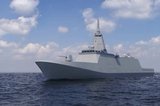In focus – composition, aims and future of UK carrier strike
When HMS Queen Elizabeth departs the UK later this year to begin the deployment of the country’s renewed carrier strike capability to the Indo-Pacific region, it is worth remembering that a decade will have passed since the decommissioning of HMS Ark Royal in 2011 and the sudden gapping of fixed-wing carrier aviation.
That the capability gap has managed to be filled at all is testament to a multitude of efforts behind the scenes in the MoD, RN and industry. External factors too will have played a role in convincing the UK that it needed to be able to perform naval
Already have an account? Log in
Want to keep reading this article?
More from Naval Warfare
-
![NATO tests use of “undetectable, jam-proof” laser communication in maritime scenarios]()
NATO tests use of “undetectable, jam-proof” laser communication in maritime scenarios
As part of its effort to better prepare its capabilities for operations in contested and congested scenarios, NATO evaluated a Lithuanian ship-to-ship terminal designed to not be susceptible to enemy interference.
-
![Future of the Canadian Patrol Submarine Project is still unclear]()
Future of the Canadian Patrol Submarine Project is still unclear
The Canadian government remains tight-lipped on the timeline and funding required for the next steps of its Canadian Submarine Patrol Project, which should offer improved capabilities for the country’s navy.
-
![Mitsubishi eyes future with Australia’s Mogami selection]()
Mitsubishi eyes future with Australia’s Mogami selection
With Australia’s selection of the Mogami-class for Project Sea 3000, Mitsubishi is investigating local production in the next decade as potential export opportunities emerge.
-
![Thales’ new Sonar 76Nano could equip UK Royal Navy on anti-submarine warfare missions]()
Thales’ new Sonar 76Nano could equip UK Royal Navy on anti-submarine warfare missions
The new sonar is designed to equip uncrewed underwater vessels, with the potential to be used by the Royal Navy for its Atlantic Bastion and Atlantic Net missions.























